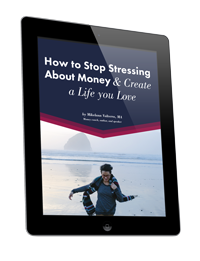 The idea of change can be overwhelming, especially when it comes to money. We love the idea of goals, but at the same time, feel overwhelmed by them. We may love the idea of having more money and less debt, but then are immediately distressed by the thought of how to get there. The key lies in beginning to make some shifts inside ourselves, like planting small seeds, since most of us know that true change comes from within. But how to do this?
The idea of change can be overwhelming, especially when it comes to money. We love the idea of goals, but at the same time, feel overwhelmed by them. We may love the idea of having more money and less debt, but then are immediately distressed by the thought of how to get there. The key lies in beginning to make some shifts inside ourselves, like planting small seeds, since most of us know that true change comes from within. But how to do this?
Recently, I was reading Loyalty to Your Soul: The Heart of Spiritual Psychology (one of my favorite subjects). The authors talk about how to use what happens in our daily life to grow spiritually. And one exercise they shared is four steps to shift things in your life that you wish were different. I immediately thought of money and all the changes that people long to make in their financial life. So, while the authors (Ron and Mary Hulnick) don’t talk about finance, their steps definitely apply, and I want to share them.
First, let’s stop for a moment and think about why making a change can feel so overwhelming. What is going on inside of us?
Part of the dilemma of making a shift is that when we contemplate making a change, we are assailed by pangs of remorse over how we have handled, or not handled, some financial matter. So, when we debate taking more personal ownership for our actions, we immediately feel guilt. We get caught up in the self-blame game and beat ourselves up. However, as the Hulnicks write, “if it is your intention to live from within a Soul-Centered context, what you want to do is accept what IS without judgement, take 100 percent responsibility for your choices, and begin making more positive choices”.
The key is to not judge yourself for what is. We are all enrolled in the school of life, and we are all learning from what we’ve gone through. All of us! Everyone’s money story is full of twists and turns. The question is how to make a shift—if what you are experiencing is no longer working. And how do you make a shift in a gentle way that leads to real change?
Here is how, in four steps:
1. What would you like to be different?
Allow yourself to get very quiet, breathe deeply for a while, and try to enter into a state of calmness. Light a candle perhaps or get your journal out. Then allow yourself to identify a current situation that you would like to be different for you, regarding money.
For example, perhaps you are stressed that you do not have any money in savings. You fear that if something happened to your job or income stream, you would be in a difficult situation. You would like to have at least a couple months of savings in the bank to cover you. But you don’t, and you feel frustrated and stressed by this.
2. Are you aware of any choices (inner or outer) you are making that are helping to maintain the current situation?
Perhaps you think that you don’t deserve to have savings, and that you don’t really like thinking about the future. And perhaps in the outer world, you name the fact that you have not opened a savings account dedicated to this kind of savings. Or perhaps you have this savings account set up, but you have not set up an automatic transfer of money each month from your checking to your savings account. You are also aware that you are maintaining the current situation of not having money in savings because you are going out to eat four night a week, and this is draining your account.
Remember, you are not judging yourself. You are simply naming the various choices you are currently making that may be keeping the current situation going. If you are stuck, try finishing these statements: “Inwardly I am aware that… Outwardly I seem to be choosing to do…. Outwardly, I seem to not be taking any action on…”
3. Brainstorm other possibilities
Now brainstorm the possibility of other choices that could give you different results. As the Hulnicks write, “It’s not that you have to do anything differently; can you simply see any alternatives?”
In our example, you could choose to tell yourself that you do deserve to have savings. And that the future is a positive thing, and you welcome it. (Though you may not currently believe these things, you can say them.) You see that it is possible to set up a new savings account online with your bank. Or you imagine that it’s possible to set up a monthly transfer of a small amount of money from your checking to a dedicated savings account. It may also be possible to eat out twice a week instead of four.
These are all simply possibilities. That is all—just possibilities. This is not about taking action. Simply allow yourself to brainstorm.
4. Visualize
This last step is about visualization and planting a new seed. Think back to your brainstorming. You want to pick some of these ideas to visualize. Which ones draw you, or strike you as having possibilities?
Visualize yourself in the process of making these new choices, and visualize this in the present moment, present tense. This is not about committing to actually doing anything different right now! This step is about visualizing yourself making different choices. See yourself taking different actions. Imagine what it would feel like to take these actions.
You may see yourself getting online with a cup of coffee and setting up a new account. You may see yourself setting up automatic transfers. You visualize talking with your close friends about going out to eat at less expensive restaurants, or only two days a week. You see yourself sharing your money goals with your close girlfriends. You tell yourself, “I am worthy of having savings.” You visualize all of this in detail, including the feelings.
Remember, this step is not about action. It is about visualization.
And here is the key with this last step. I want you to imagine doing this visualization every day for a month. Yes, that’s right—a month! Whether it is first thing in the morning or when you go to bed at night, run through this visualization. Our outward behavior shifts when our inner thoughts and feelings shift. So commit to visualizing this every day.
How will you do this? Can you put a reminder on your phone? Can you put a card on your pillow that you see when you go to bed each night? How will you go through this visualization every day for 30 days?
True change
True change comes when we first see it internally. Don’t force change on yourself without trying to gently give your mind and emotions a new possibility. Behavior follows thoughts and feelings, not the other way around. So now is the time to begin to write a new internal program.
The daily repetition of this visualization will lay down new potent seeds in your mind and spirit. Then taking actions becomes easier and easier. In time, new actions bloom in the outer realm of your life, grounded in the fertile soil of your inner shifts.
Ready to earn more and step into greater freedom? Click here to be notified of the next time Mikelann offers her 8 week Unlock Your Earning Power course.

